Theories in Counselling: A CBT Analysis of Tom's Case Study
VerifiedAdded on 2022/08/31
|8
|2296
|20
Report
AI Summary
This report provides a detailed analysis of a case study involving an ex-military personnel named Tom, who is struggling with anxiety, alcoholism, and legal issues stemming from his military service. The report focuses on applying Cognitive Behavioral Therapy (CBT) to address Tom's challenges. It begins with an introduction to CBT, its principles, and its effectiveness in treating anxiety and related issues. The report then delves into the background of CBT, tracing its roots in behaviorism and cognitivism, and highlighting key figures in its development, such as Aaron T. Beck. The core of the report examines the client-therapist relationship within CBT and its application to Tom's specific case, breaking down his issues into alcoholism, anxiety, and abusive behavior. It outlines how CBT techniques, including identifying and challenging negative thoughts, can be used to help Tom manage his anxiety, overcome alcoholism, and address his violent tendencies. Ethical considerations are also discussed, emphasizing the importance of confidentiality and client autonomy. The report concludes by summarizing the potential benefits of CBT for Tom, emphasizing the importance of consistent therapy sessions and the potential for positive behavioral changes. References to relevant research and literature are also included.
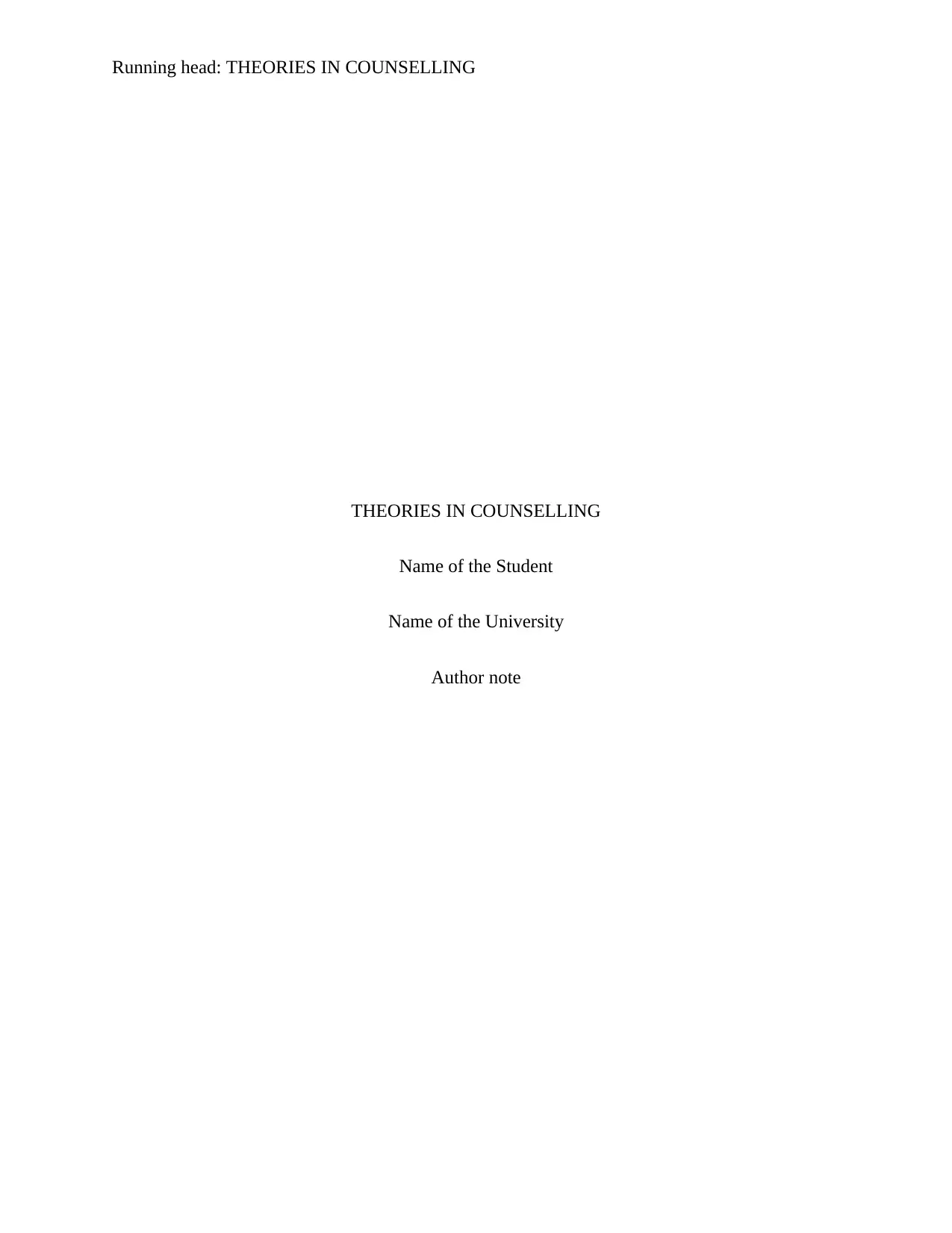
Running head: THEORIES IN COUNSELLING
THEORIES IN COUNSELLING
Name of the Student
Name of the University
Author note
THEORIES IN COUNSELLING
Name of the Student
Name of the University
Author note
Paraphrase This Document
Need a fresh take? Get an instant paraphrase of this document with our AI Paraphraser
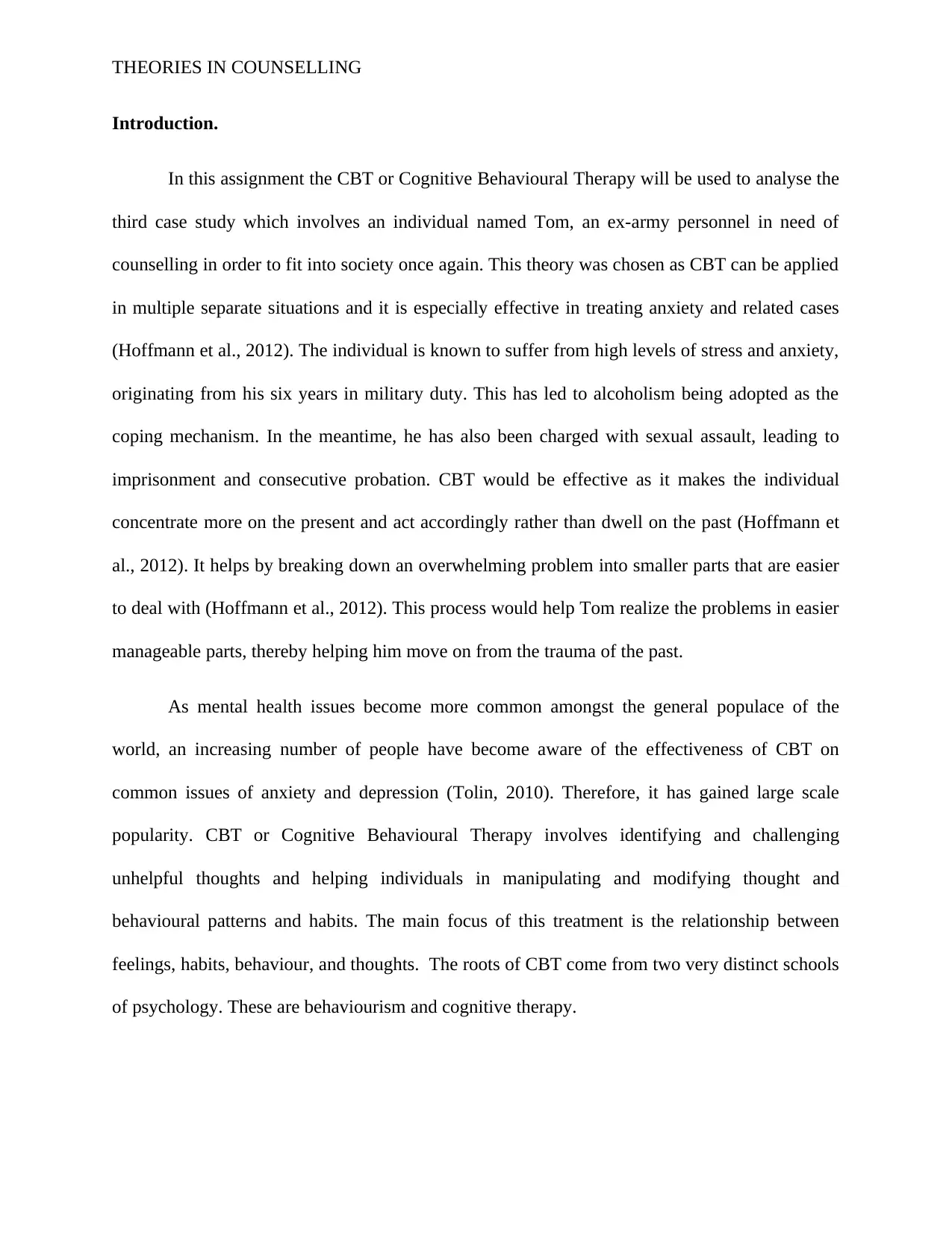
THEORIES IN COUNSELLING
Introduction.
In this assignment the CBT or Cognitive Behavioural Therapy will be used to analyse the
third case study which involves an individual named Tom, an ex-army personnel in need of
counselling in order to fit into society once again. This theory was chosen as CBT can be applied
in multiple separate situations and it is especially effective in treating anxiety and related cases
(Hoffmann et al., 2012). The individual is known to suffer from high levels of stress and anxiety,
originating from his six years in military duty. This has led to alcoholism being adopted as the
coping mechanism. In the meantime, he has also been charged with sexual assault, leading to
imprisonment and consecutive probation. CBT would be effective as it makes the individual
concentrate more on the present and act accordingly rather than dwell on the past (Hoffmann et
al., 2012). It helps by breaking down an overwhelming problem into smaller parts that are easier
to deal with (Hoffmann et al., 2012). This process would help Tom realize the problems in easier
manageable parts, thereby helping him move on from the trauma of the past.
As mental health issues become more common amongst the general populace of the
world, an increasing number of people have become aware of the effectiveness of CBT on
common issues of anxiety and depression (Tolin, 2010). Therefore, it has gained large scale
popularity. CBT or Cognitive Behavioural Therapy involves identifying and challenging
unhelpful thoughts and helping individuals in manipulating and modifying thought and
behavioural patterns and habits. The main focus of this treatment is the relationship between
feelings, habits, behaviour, and thoughts. The roots of CBT come from two very distinct schools
of psychology. These are behaviourism and cognitive therapy.
Introduction.
In this assignment the CBT or Cognitive Behavioural Therapy will be used to analyse the
third case study which involves an individual named Tom, an ex-army personnel in need of
counselling in order to fit into society once again. This theory was chosen as CBT can be applied
in multiple separate situations and it is especially effective in treating anxiety and related cases
(Hoffmann et al., 2012). The individual is known to suffer from high levels of stress and anxiety,
originating from his six years in military duty. This has led to alcoholism being adopted as the
coping mechanism. In the meantime, he has also been charged with sexual assault, leading to
imprisonment and consecutive probation. CBT would be effective as it makes the individual
concentrate more on the present and act accordingly rather than dwell on the past (Hoffmann et
al., 2012). It helps by breaking down an overwhelming problem into smaller parts that are easier
to deal with (Hoffmann et al., 2012). This process would help Tom realize the problems in easier
manageable parts, thereby helping him move on from the trauma of the past.
As mental health issues become more common amongst the general populace of the
world, an increasing number of people have become aware of the effectiveness of CBT on
common issues of anxiety and depression (Tolin, 2010). Therefore, it has gained large scale
popularity. CBT or Cognitive Behavioural Therapy involves identifying and challenging
unhelpful thoughts and helping individuals in manipulating and modifying thought and
behavioural patterns and habits. The main focus of this treatment is the relationship between
feelings, habits, behaviour, and thoughts. The roots of CBT come from two very distinct schools
of psychology. These are behaviourism and cognitive therapy.
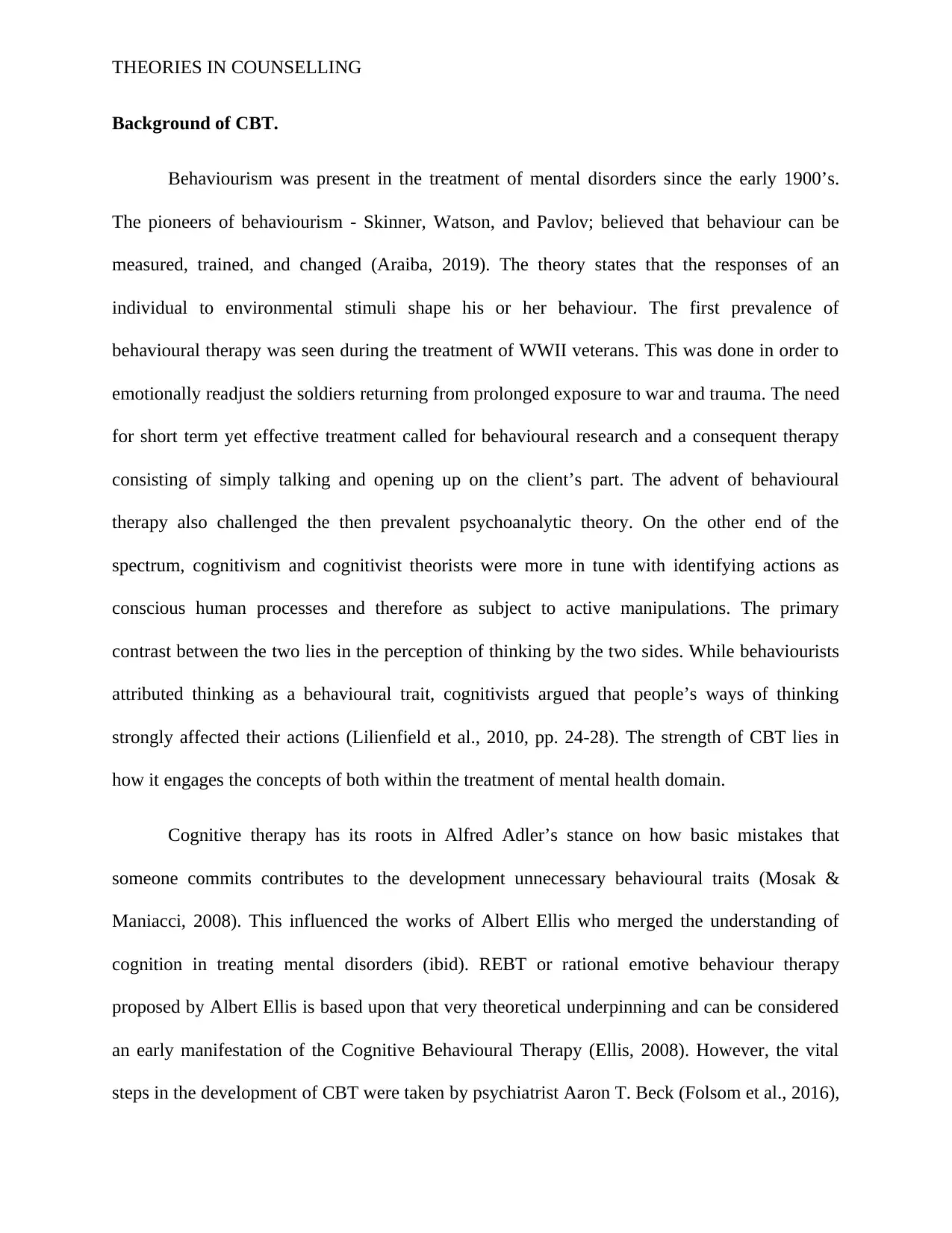
THEORIES IN COUNSELLING
Background of CBT.
Behaviourism was present in the treatment of mental disorders since the early 1900’s.
The pioneers of behaviourism - Skinner, Watson, and Pavlov; believed that behaviour can be
measured, trained, and changed (Araiba, 2019). The theory states that the responses of an
individual to environmental stimuli shape his or her behaviour. The first prevalence of
behavioural therapy was seen during the treatment of WWII veterans. This was done in order to
emotionally readjust the soldiers returning from prolonged exposure to war and trauma. The need
for short term yet effective treatment called for behavioural research and a consequent therapy
consisting of simply talking and opening up on the client’s part. The advent of behavioural
therapy also challenged the then prevalent psychoanalytic theory. On the other end of the
spectrum, cognitivism and cognitivist theorists were more in tune with identifying actions as
conscious human processes and therefore as subject to active manipulations. The primary
contrast between the two lies in the perception of thinking by the two sides. While behaviourists
attributed thinking as a behavioural trait, cognitivists argued that people’s ways of thinking
strongly affected their actions (Lilienfield et al., 2010, pp. 24-28). The strength of CBT lies in
how it engages the concepts of both within the treatment of mental health domain.
Cognitive therapy has its roots in Alfred Adler’s stance on how basic mistakes that
someone commits contributes to the development unnecessary behavioural traits (Mosak &
Maniacci, 2008). This influenced the works of Albert Ellis who merged the understanding of
cognition in treating mental disorders (ibid). REBT or rational emotive behaviour therapy
proposed by Albert Ellis is based upon that very theoretical underpinning and can be considered
an early manifestation of the Cognitive Behavioural Therapy (Ellis, 2008). However, the vital
steps in the development of CBT were taken by psychiatrist Aaron T. Beck (Folsom et al., 2016),
Background of CBT.
Behaviourism was present in the treatment of mental disorders since the early 1900’s.
The pioneers of behaviourism - Skinner, Watson, and Pavlov; believed that behaviour can be
measured, trained, and changed (Araiba, 2019). The theory states that the responses of an
individual to environmental stimuli shape his or her behaviour. The first prevalence of
behavioural therapy was seen during the treatment of WWII veterans. This was done in order to
emotionally readjust the soldiers returning from prolonged exposure to war and trauma. The need
for short term yet effective treatment called for behavioural research and a consequent therapy
consisting of simply talking and opening up on the client’s part. The advent of behavioural
therapy also challenged the then prevalent psychoanalytic theory. On the other end of the
spectrum, cognitivism and cognitivist theorists were more in tune with identifying actions as
conscious human processes and therefore as subject to active manipulations. The primary
contrast between the two lies in the perception of thinking by the two sides. While behaviourists
attributed thinking as a behavioural trait, cognitivists argued that people’s ways of thinking
strongly affected their actions (Lilienfield et al., 2010, pp. 24-28). The strength of CBT lies in
how it engages the concepts of both within the treatment of mental health domain.
Cognitive therapy has its roots in Alfred Adler’s stance on how basic mistakes that
someone commits contributes to the development unnecessary behavioural traits (Mosak &
Maniacci, 2008). This influenced the works of Albert Ellis who merged the understanding of
cognition in treating mental disorders (ibid). REBT or rational emotive behaviour therapy
proposed by Albert Ellis is based upon that very theoretical underpinning and can be considered
an early manifestation of the Cognitive Behavioural Therapy (Ellis, 2008). However, the vital
steps in the development of CBT were taken by psychiatrist Aaron T. Beck (Folsom et al., 2016),
⊘ This is a preview!⊘
Do you want full access?
Subscribe today to unlock all pages.

Trusted by 1+ million students worldwide
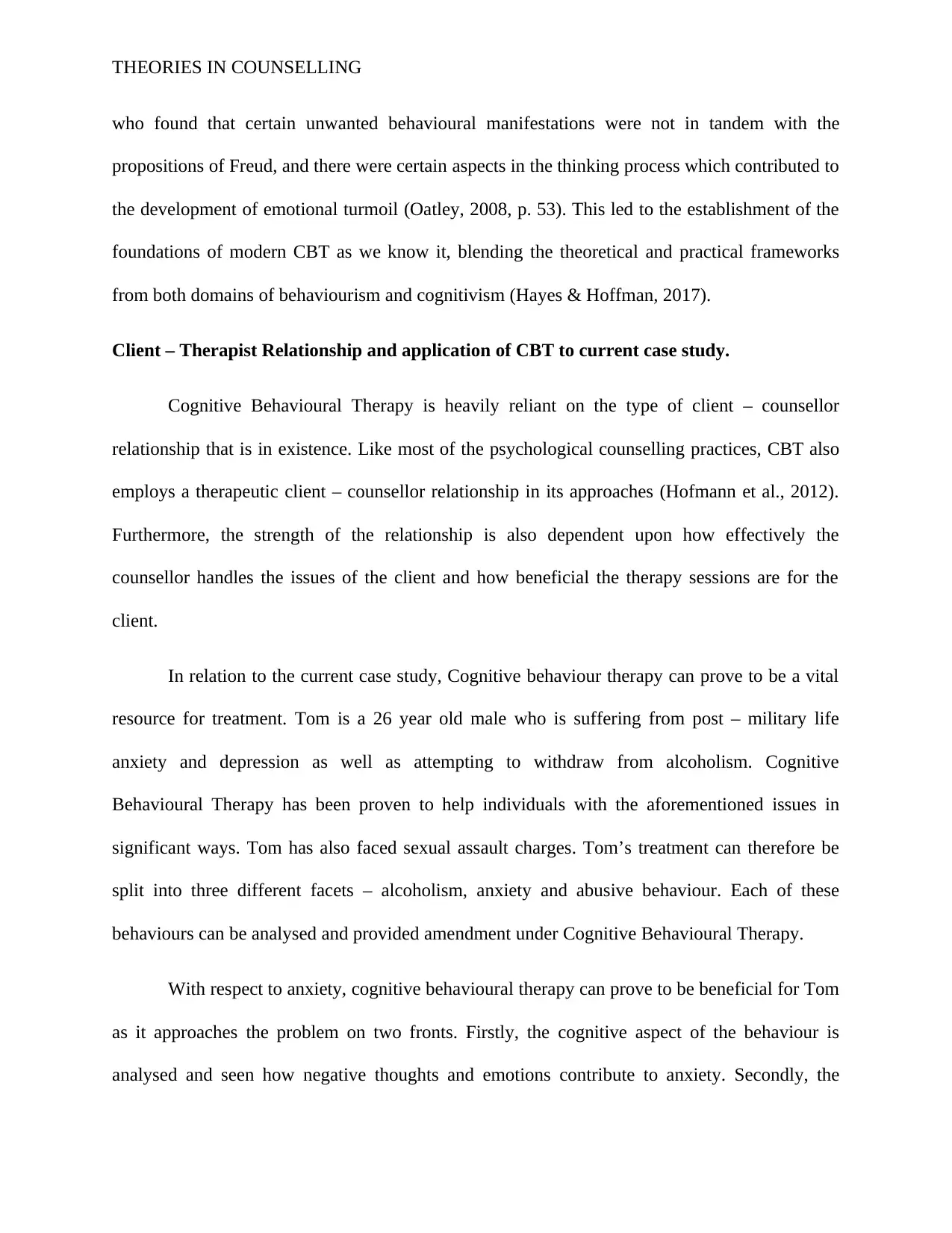
THEORIES IN COUNSELLING
who found that certain unwanted behavioural manifestations were not in tandem with the
propositions of Freud, and there were certain aspects in the thinking process which contributed to
the development of emotional turmoil (Oatley, 2008, p. 53). This led to the establishment of the
foundations of modern CBT as we know it, blending the theoretical and practical frameworks
from both domains of behaviourism and cognitivism (Hayes & Hoffman, 2017).
Client – Therapist Relationship and application of CBT to current case study.
Cognitive Behavioural Therapy is heavily reliant on the type of client – counsellor
relationship that is in existence. Like most of the psychological counselling practices, CBT also
employs a therapeutic client – counsellor relationship in its approaches (Hofmann et al., 2012).
Furthermore, the strength of the relationship is also dependent upon how effectively the
counsellor handles the issues of the client and how beneficial the therapy sessions are for the
client.
In relation to the current case study, Cognitive behaviour therapy can prove to be a vital
resource for treatment. Tom is a 26 year old male who is suffering from post – military life
anxiety and depression as well as attempting to withdraw from alcoholism. Cognitive
Behavioural Therapy has been proven to help individuals with the aforementioned issues in
significant ways. Tom has also faced sexual assault charges. Tom’s treatment can therefore be
split into three different facets – alcoholism, anxiety and abusive behaviour. Each of these
behaviours can be analysed and provided amendment under Cognitive Behavioural Therapy.
With respect to anxiety, cognitive behavioural therapy can prove to be beneficial for Tom
as it approaches the problem on two fronts. Firstly, the cognitive aspect of the behaviour is
analysed and seen how negative thoughts and emotions contribute to anxiety. Secondly, the
who found that certain unwanted behavioural manifestations were not in tandem with the
propositions of Freud, and there were certain aspects in the thinking process which contributed to
the development of emotional turmoil (Oatley, 2008, p. 53). This led to the establishment of the
foundations of modern CBT as we know it, blending the theoretical and practical frameworks
from both domains of behaviourism and cognitivism (Hayes & Hoffman, 2017).
Client – Therapist Relationship and application of CBT to current case study.
Cognitive Behavioural Therapy is heavily reliant on the type of client – counsellor
relationship that is in existence. Like most of the psychological counselling practices, CBT also
employs a therapeutic client – counsellor relationship in its approaches (Hofmann et al., 2012).
Furthermore, the strength of the relationship is also dependent upon how effectively the
counsellor handles the issues of the client and how beneficial the therapy sessions are for the
client.
In relation to the current case study, Cognitive behaviour therapy can prove to be a vital
resource for treatment. Tom is a 26 year old male who is suffering from post – military life
anxiety and depression as well as attempting to withdraw from alcoholism. Cognitive
Behavioural Therapy has been proven to help individuals with the aforementioned issues in
significant ways. Tom has also faced sexual assault charges. Tom’s treatment can therefore be
split into three different facets – alcoholism, anxiety and abusive behaviour. Each of these
behaviours can be analysed and provided amendment under Cognitive Behavioural Therapy.
With respect to anxiety, cognitive behavioural therapy can prove to be beneficial for Tom
as it approaches the problem on two fronts. Firstly, the cognitive aspect of the behaviour is
analysed and seen how negative thoughts and emotions contribute to anxiety. Secondly, the
Paraphrase This Document
Need a fresh take? Get an instant paraphrase of this document with our AI Paraphraser
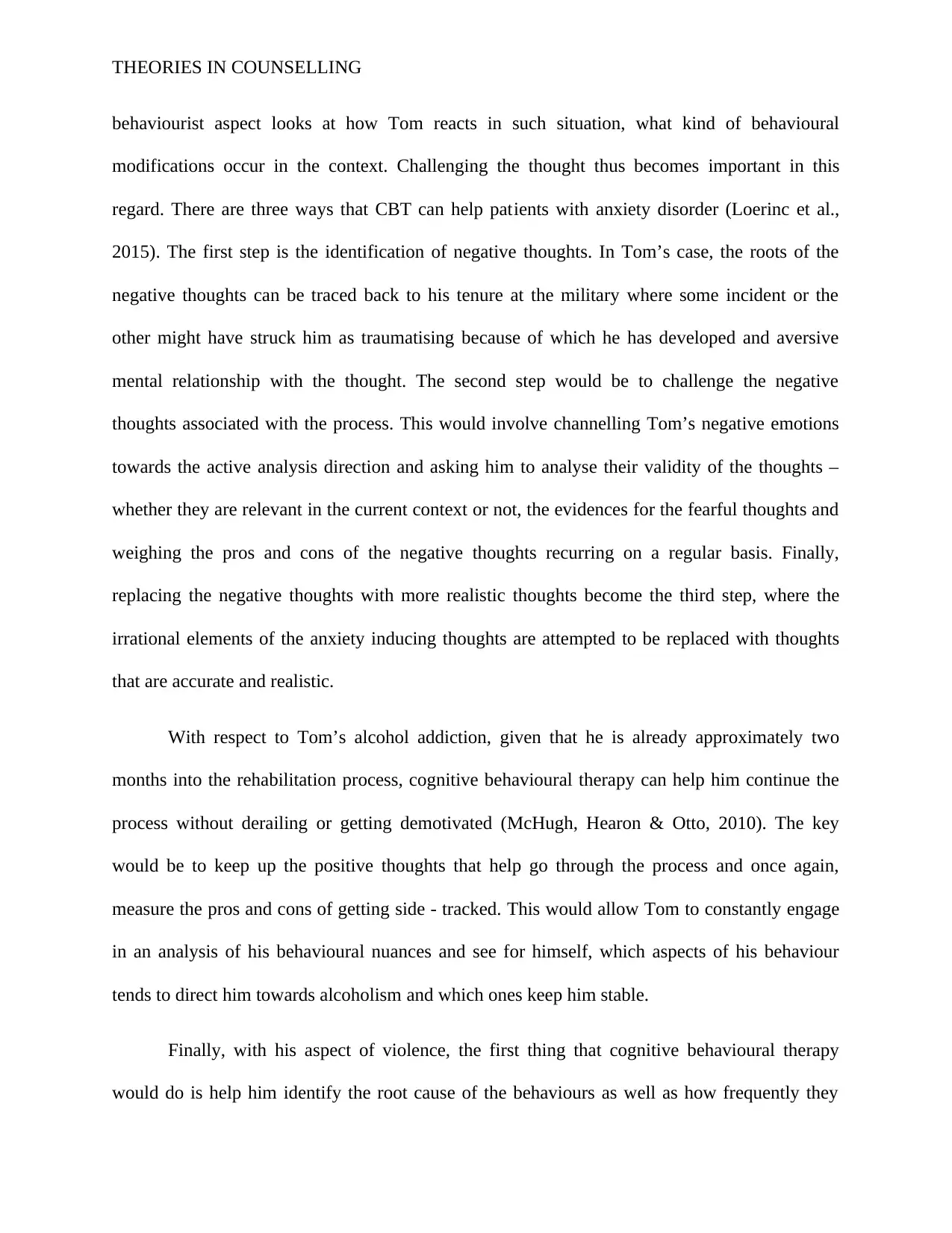
THEORIES IN COUNSELLING
behaviourist aspect looks at how Tom reacts in such situation, what kind of behavioural
modifications occur in the context. Challenging the thought thus becomes important in this
regard. There are three ways that CBT can help patients with anxiety disorder (Loerinc et al.,
2015). The first step is the identification of negative thoughts. In Tom’s case, the roots of the
negative thoughts can be traced back to his tenure at the military where some incident or the
other might have struck him as traumatising because of which he has developed and aversive
mental relationship with the thought. The second step would be to challenge the negative
thoughts associated with the process. This would involve channelling Tom’s negative emotions
towards the active analysis direction and asking him to analyse their validity of the thoughts –
whether they are relevant in the current context or not, the evidences for the fearful thoughts and
weighing the pros and cons of the negative thoughts recurring on a regular basis. Finally,
replacing the negative thoughts with more realistic thoughts become the third step, where the
irrational elements of the anxiety inducing thoughts are attempted to be replaced with thoughts
that are accurate and realistic.
With respect to Tom’s alcohol addiction, given that he is already approximately two
months into the rehabilitation process, cognitive behavioural therapy can help him continue the
process without derailing or getting demotivated (McHugh, Hearon & Otto, 2010). The key
would be to keep up the positive thoughts that help go through the process and once again,
measure the pros and cons of getting side - tracked. This would allow Tom to constantly engage
in an analysis of his behavioural nuances and see for himself, which aspects of his behaviour
tends to direct him towards alcoholism and which ones keep him stable.
Finally, with his aspect of violence, the first thing that cognitive behavioural therapy
would do is help him identify the root cause of the behaviours as well as how frequently they
behaviourist aspect looks at how Tom reacts in such situation, what kind of behavioural
modifications occur in the context. Challenging the thought thus becomes important in this
regard. There are three ways that CBT can help patients with anxiety disorder (Loerinc et al.,
2015). The first step is the identification of negative thoughts. In Tom’s case, the roots of the
negative thoughts can be traced back to his tenure at the military where some incident or the
other might have struck him as traumatising because of which he has developed and aversive
mental relationship with the thought. The second step would be to challenge the negative
thoughts associated with the process. This would involve channelling Tom’s negative emotions
towards the active analysis direction and asking him to analyse their validity of the thoughts –
whether they are relevant in the current context or not, the evidences for the fearful thoughts and
weighing the pros and cons of the negative thoughts recurring on a regular basis. Finally,
replacing the negative thoughts with more realistic thoughts become the third step, where the
irrational elements of the anxiety inducing thoughts are attempted to be replaced with thoughts
that are accurate and realistic.
With respect to Tom’s alcohol addiction, given that he is already approximately two
months into the rehabilitation process, cognitive behavioural therapy can help him continue the
process without derailing or getting demotivated (McHugh, Hearon & Otto, 2010). The key
would be to keep up the positive thoughts that help go through the process and once again,
measure the pros and cons of getting side - tracked. This would allow Tom to constantly engage
in an analysis of his behavioural nuances and see for himself, which aspects of his behaviour
tends to direct him towards alcoholism and which ones keep him stable.
Finally, with his aspect of violence, the first thing that cognitive behavioural therapy
would do is help him identify the root cause of the behaviours as well as how frequently they
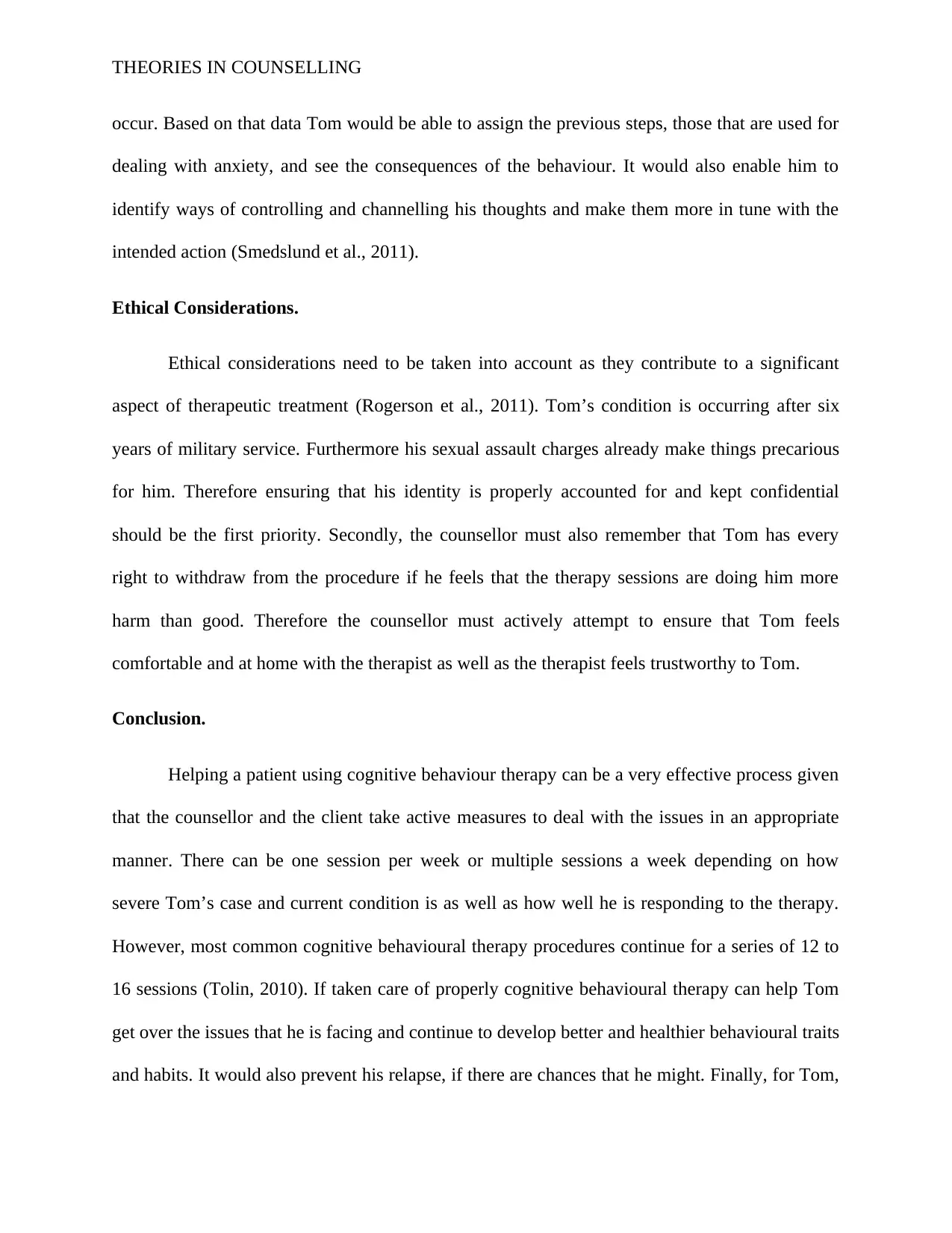
THEORIES IN COUNSELLING
occur. Based on that data Tom would be able to assign the previous steps, those that are used for
dealing with anxiety, and see the consequences of the behaviour. It would also enable him to
identify ways of controlling and channelling his thoughts and make them more in tune with the
intended action (Smedslund et al., 2011).
Ethical Considerations.
Ethical considerations need to be taken into account as they contribute to a significant
aspect of therapeutic treatment (Rogerson et al., 2011). Tom’s condition is occurring after six
years of military service. Furthermore his sexual assault charges already make things precarious
for him. Therefore ensuring that his identity is properly accounted for and kept confidential
should be the first priority. Secondly, the counsellor must also remember that Tom has every
right to withdraw from the procedure if he feels that the therapy sessions are doing him more
harm than good. Therefore the counsellor must actively attempt to ensure that Tom feels
comfortable and at home with the therapist as well as the therapist feels trustworthy to Tom.
Conclusion.
Helping a patient using cognitive behaviour therapy can be a very effective process given
that the counsellor and the client take active measures to deal with the issues in an appropriate
manner. There can be one session per week or multiple sessions a week depending on how
severe Tom’s case and current condition is as well as how well he is responding to the therapy.
However, most common cognitive behavioural therapy procedures continue for a series of 12 to
16 sessions (Tolin, 2010). If taken care of properly cognitive behavioural therapy can help Tom
get over the issues that he is facing and continue to develop better and healthier behavioural traits
and habits. It would also prevent his relapse, if there are chances that he might. Finally, for Tom,
occur. Based on that data Tom would be able to assign the previous steps, those that are used for
dealing with anxiety, and see the consequences of the behaviour. It would also enable him to
identify ways of controlling and channelling his thoughts and make them more in tune with the
intended action (Smedslund et al., 2011).
Ethical Considerations.
Ethical considerations need to be taken into account as they contribute to a significant
aspect of therapeutic treatment (Rogerson et al., 2011). Tom’s condition is occurring after six
years of military service. Furthermore his sexual assault charges already make things precarious
for him. Therefore ensuring that his identity is properly accounted for and kept confidential
should be the first priority. Secondly, the counsellor must also remember that Tom has every
right to withdraw from the procedure if he feels that the therapy sessions are doing him more
harm than good. Therefore the counsellor must actively attempt to ensure that Tom feels
comfortable and at home with the therapist as well as the therapist feels trustworthy to Tom.
Conclusion.
Helping a patient using cognitive behaviour therapy can be a very effective process given
that the counsellor and the client take active measures to deal with the issues in an appropriate
manner. There can be one session per week or multiple sessions a week depending on how
severe Tom’s case and current condition is as well as how well he is responding to the therapy.
However, most common cognitive behavioural therapy procedures continue for a series of 12 to
16 sessions (Tolin, 2010). If taken care of properly cognitive behavioural therapy can help Tom
get over the issues that he is facing and continue to develop better and healthier behavioural traits
and habits. It would also prevent his relapse, if there are chances that he might. Finally, for Tom,
⊘ This is a preview!⊘
Do you want full access?
Subscribe today to unlock all pages.

Trusted by 1+ million students worldwide
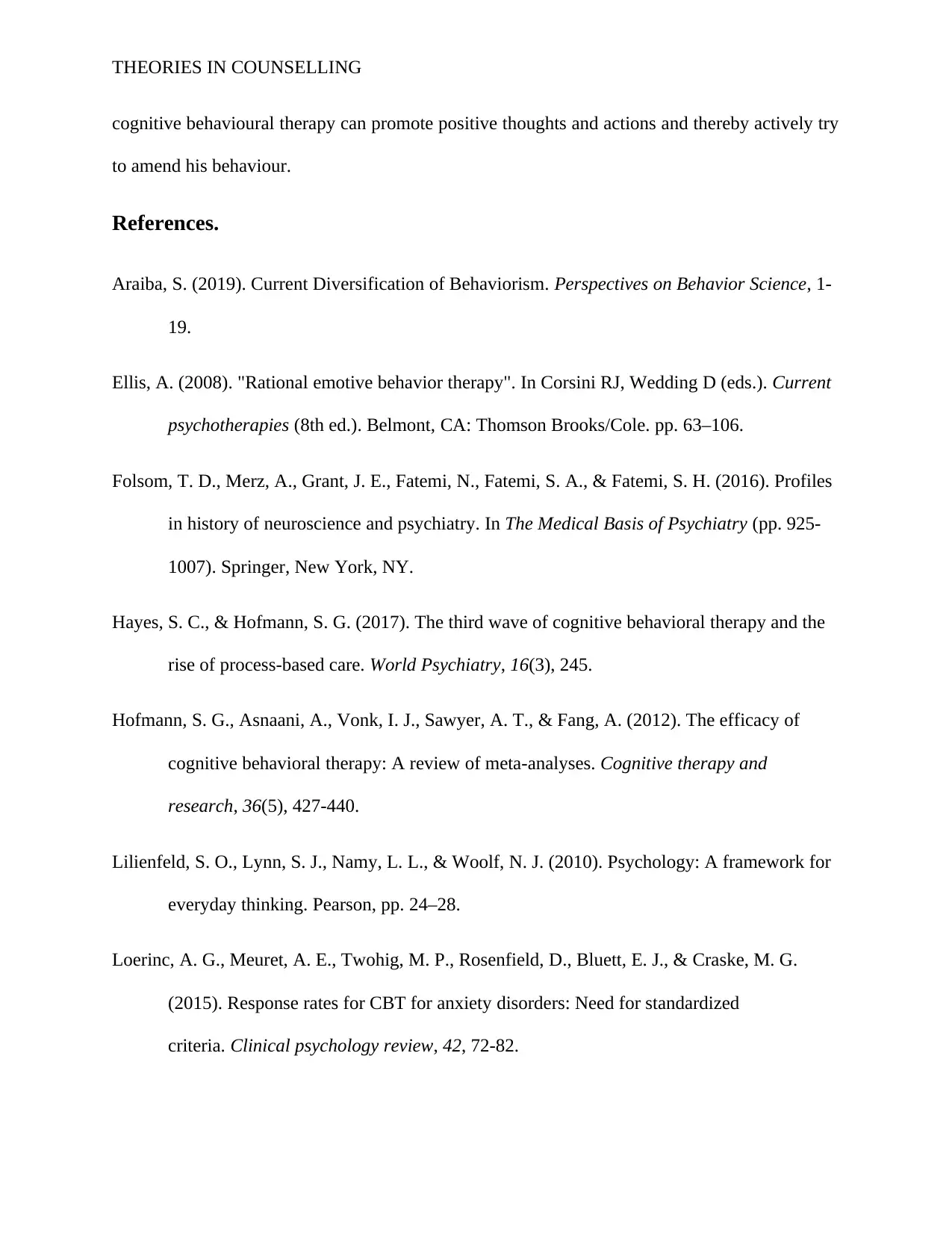
THEORIES IN COUNSELLING
cognitive behavioural therapy can promote positive thoughts and actions and thereby actively try
to amend his behaviour.
References.
Araiba, S. (2019). Current Diversification of Behaviorism. Perspectives on Behavior Science, 1-
19.
Ellis, A. (2008). "Rational emotive behavior therapy". In Corsini RJ, Wedding D (eds.). Current
psychotherapies (8th ed.). Belmont, CA: Thomson Brooks/Cole. pp. 63–106.
Folsom, T. D., Merz, A., Grant, J. E., Fatemi, N., Fatemi, S. A., & Fatemi, S. H. (2016). Profiles
in history of neuroscience and psychiatry. In The Medical Basis of Psychiatry (pp. 925-
1007). Springer, New York, NY.
Hayes, S. C., & Hofmann, S. G. (2017). The third wave of cognitive behavioral therapy and the
rise of process‐based care. World Psychiatry, 16(3), 245.
Hofmann, S. G., Asnaani, A., Vonk, I. J., Sawyer, A. T., & Fang, A. (2012). The efficacy of
cognitive behavioral therapy: A review of meta-analyses. Cognitive therapy and
research, 36(5), 427-440.
Lilienfeld, S. O., Lynn, S. J., Namy, L. L., & Woolf, N. J. (2010). Psychology: A framework for
everyday thinking. Pearson, pp. 24–28.
Loerinc, A. G., Meuret, A. E., Twohig, M. P., Rosenfield, D., Bluett, E. J., & Craske, M. G.
(2015). Response rates for CBT for anxiety disorders: Need for standardized
criteria. Clinical psychology review, 42, 72-82.
cognitive behavioural therapy can promote positive thoughts and actions and thereby actively try
to amend his behaviour.
References.
Araiba, S. (2019). Current Diversification of Behaviorism. Perspectives on Behavior Science, 1-
19.
Ellis, A. (2008). "Rational emotive behavior therapy". In Corsini RJ, Wedding D (eds.). Current
psychotherapies (8th ed.). Belmont, CA: Thomson Brooks/Cole. pp. 63–106.
Folsom, T. D., Merz, A., Grant, J. E., Fatemi, N., Fatemi, S. A., & Fatemi, S. H. (2016). Profiles
in history of neuroscience and psychiatry. In The Medical Basis of Psychiatry (pp. 925-
1007). Springer, New York, NY.
Hayes, S. C., & Hofmann, S. G. (2017). The third wave of cognitive behavioral therapy and the
rise of process‐based care. World Psychiatry, 16(3), 245.
Hofmann, S. G., Asnaani, A., Vonk, I. J., Sawyer, A. T., & Fang, A. (2012). The efficacy of
cognitive behavioral therapy: A review of meta-analyses. Cognitive therapy and
research, 36(5), 427-440.
Lilienfeld, S. O., Lynn, S. J., Namy, L. L., & Woolf, N. J. (2010). Psychology: A framework for
everyday thinking. Pearson, pp. 24–28.
Loerinc, A. G., Meuret, A. E., Twohig, M. P., Rosenfield, D., Bluett, E. J., & Craske, M. G.
(2015). Response rates for CBT for anxiety disorders: Need for standardized
criteria. Clinical psychology review, 42, 72-82.
Paraphrase This Document
Need a fresh take? Get an instant paraphrase of this document with our AI Paraphraser
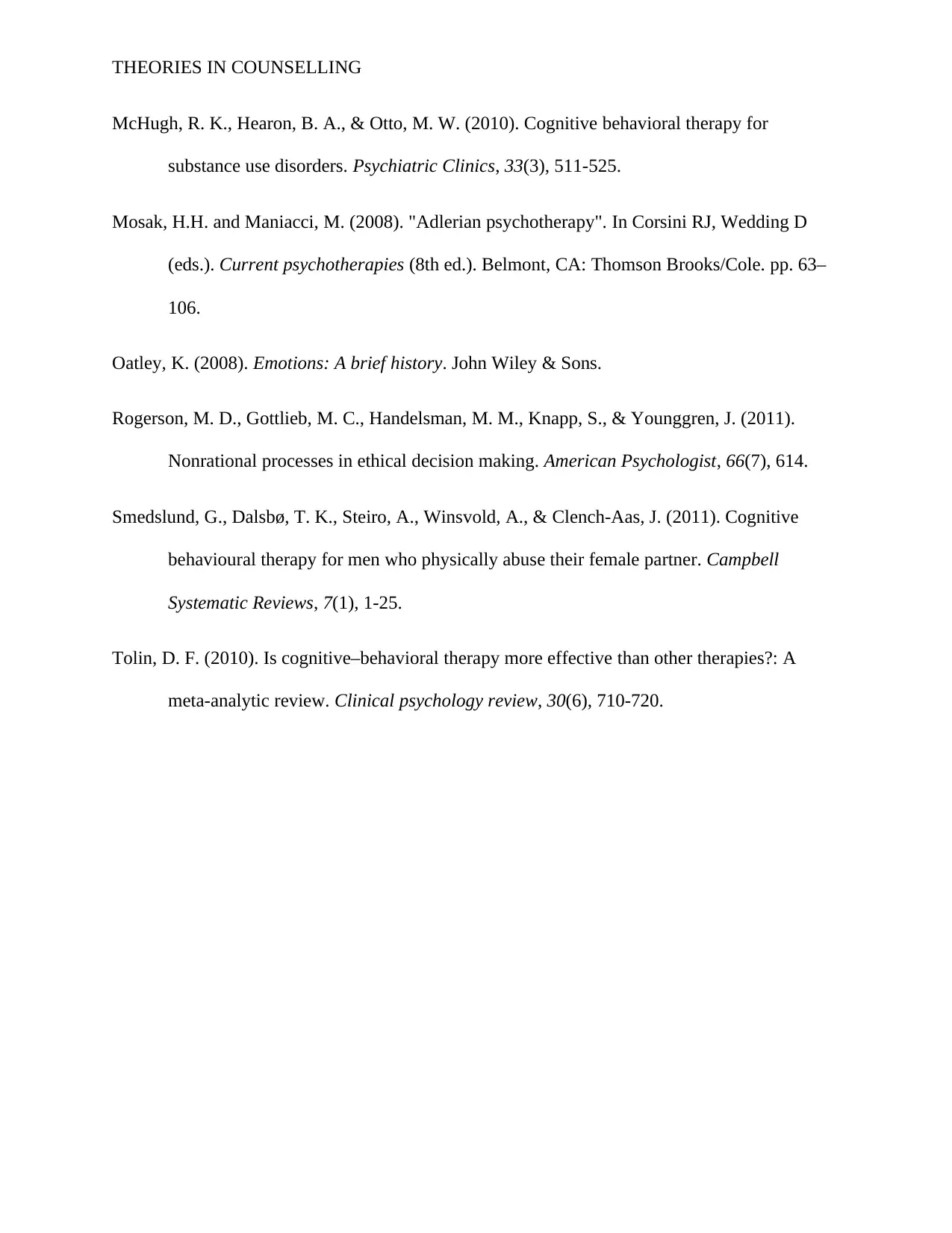
THEORIES IN COUNSELLING
McHugh, R. K., Hearon, B. A., & Otto, M. W. (2010). Cognitive behavioral therapy for
substance use disorders. Psychiatric Clinics, 33(3), 511-525.
Mosak, H.H. and Maniacci, M. (2008). "Adlerian psychotherapy". In Corsini RJ, Wedding D
(eds.). Current psychotherapies (8th ed.). Belmont, CA: Thomson Brooks/Cole. pp. 63–
106.
Oatley, K. (2008). Emotions: A brief history. John Wiley & Sons.
Rogerson, M. D., Gottlieb, M. C., Handelsman, M. M., Knapp, S., & Younggren, J. (2011).
Nonrational processes in ethical decision making. American Psychologist, 66(7), 614.
Smedslund, G., Dalsbø, T. K., Steiro, A., Winsvold, A., & Clench‐Aas, J. (2011). Cognitive
behavioural therapy for men who physically abuse their female partner. Campbell
Systematic Reviews, 7(1), 1-25.
Tolin, D. F. (2010). Is cognitive–behavioral therapy more effective than other therapies?: A
meta-analytic review. Clinical psychology review, 30(6), 710-720.
McHugh, R. K., Hearon, B. A., & Otto, M. W. (2010). Cognitive behavioral therapy for
substance use disorders. Psychiatric Clinics, 33(3), 511-525.
Mosak, H.H. and Maniacci, M. (2008). "Adlerian psychotherapy". In Corsini RJ, Wedding D
(eds.). Current psychotherapies (8th ed.). Belmont, CA: Thomson Brooks/Cole. pp. 63–
106.
Oatley, K. (2008). Emotions: A brief history. John Wiley & Sons.
Rogerson, M. D., Gottlieb, M. C., Handelsman, M. M., Knapp, S., & Younggren, J. (2011).
Nonrational processes in ethical decision making. American Psychologist, 66(7), 614.
Smedslund, G., Dalsbø, T. K., Steiro, A., Winsvold, A., & Clench‐Aas, J. (2011). Cognitive
behavioural therapy for men who physically abuse their female partner. Campbell
Systematic Reviews, 7(1), 1-25.
Tolin, D. F. (2010). Is cognitive–behavioral therapy more effective than other therapies?: A
meta-analytic review. Clinical psychology review, 30(6), 710-720.
1 out of 8
Related Documents
Your All-in-One AI-Powered Toolkit for Academic Success.
+13062052269
info@desklib.com
Available 24*7 on WhatsApp / Email
![[object Object]](/_next/static/media/star-bottom.7253800d.svg)
Unlock your academic potential
Copyright © 2020–2025 A2Z Services. All Rights Reserved. Developed and managed by ZUCOL.




